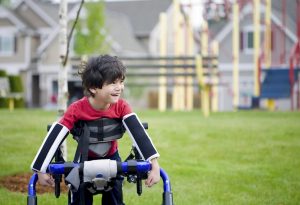
Spastic Cerebral Palsy is the most common form of the condition, accounting for over 70% of all cases.
Cerebral Palsy is a condition that is typically caused by brain damage before or during the birth process that can permanently affect a person’s physical and mental abilities. There are four types of Cerebral Palsy and Spastic is the most common, accounting for over 70% of all diagnoses. This type is mostly characterized by muscle tightness, joint stiffness, and muscle spasms. Here is what you need to know about Spastic Cerebral Palsy.
Types of Spastic Cerebral Palsy
Each type of Cerebral Palsy can be broken down to further specify an individual’s symptoms. The types of Spastic Cerebral Palsy are as follows:
- Spastic Diplegia: The muscle stiffness is mostly prevalent in the legs. This type may also have a slight impact on the child’s arm movements.
- Spastic Hemiplegia: One entire side of the body has problems with movement. Typically, the arms are stiffer than the legs.
- Spastic Quadriplegia: This is the most severe type, affecting all four limbs, the face, and torso. Children with this type often have other disorders as a result such as epilepsy.
Causes
Spastic Cerebral Palsy occurs when there is damage to the motor cortex and pyramidal tracts of the brain. The motor cortex is in the cerebral cortex and is responsible for sending signals to other parts of the brain to control our movements. Damage to the motor cortex makes it harder for a person to move voluntarily, causing muscle spasms and tightness. The pyramidal tracts communicate between the cerebral cortex and the spinal cord. Damage to this makes it so that the motor cortex can’t send signals to the spinal cord. These parts of the brain can be damaged by a prenatal brain hemorrhage, brain trauma after birth, or birth asphyxia.
Treatment
There are five main types of treatment for Spastic Cerebral Palsy and the method used depends on the child’s specific symptoms.
- Physical Therapy: Use of range-of-motion and stretching exercises to help improve the mobility of a child’s joints and give them as much independence as possible.
- Occupational Therapy: Uses exercises that focus on the wrist, thumbs, forearm, and upper body. It helps with motor control and upper body strength.
- Speech Therapy: Some children with Spastic Cerebral Palsy have trouble with speech. This therapy helps to strengthen muscles used for speech which can also help with coordination.
- Medication: There are medications prescribed to patients that can help to relieve stiffness and increase movement, some made to help specific body parts. They also have different medications for those children that experience seizures.
- Surgery: Selective Doral Rhizotomy is the most common surgery used for Spastic Cerebral Palsy, designed to relax muscles and help improve mobility.
Does Your Child Have Cerebral Palsy as a result of a Medical Mistake? Contact The Snyder Law Group Today
The Snyder Law Group, LLC, proudly represents clients through Maryland and Washington D.C. Our experienced Baltimore attorneys understand the frustration that comes with an insurance company, medical professional, or other party that refuses to accept liability for negligence or reckless behavior. You can take heart in knowing there are talented and experienced lawyers ready to work for you. We are experienced in handling personal injury claims that result from medical malpractice or injury resulting from serious car or truck accidents and have secured hundreds of millions in verdict settlements. Give us a call at (410)-843-3476 for a free case evaluation. You can also visit our website www.410thefirm.com and follow us on Facebook, Twitter, Google +, and LinkedIn for more information.
